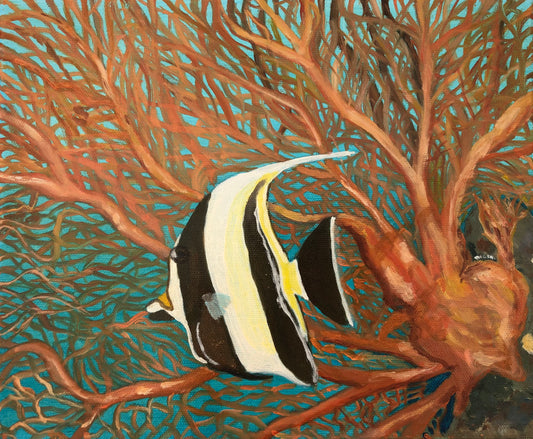Whether you’re commissioning a bespoke artwork or choosing a special piece for your space, asking the right questions at the start can make all the difference. Art has the power to transform a room, anchor a mood, and tell a personal story — but its success depends on both creative intention and practical placement.
Here are 10 questions to help guide your decision-making process:
1. What is the purpose of the artwork in your space?
Are you looking for a dramatic statement piece above the fireplace, a calming presence in a bedroom, or something to pull together a gallery wall? Understanding the role art plays in your space — decorative, emotional, or functional — will guide the style, size, and palette.
Design Tip: Anchor large, open spaces with bold statement pieces; use smaller, more detailed artworks in intimate or transitional areas like reading nooks or hallways.
2. What emotions or atmosphere do you want the artwork to evoke?
Art is a powerful mood-setter. Consider what you want to feel when you look at the piece — peace, energy, joy, wonder, nostalgia? This emotional goal can shape your choice of subject matter, composition, and colour palette.
Design Tip: Cool blues and soft neutrals tend to calm; warm tones like terracotta or coral can energize a room. Don’t underestimate the mood-setting power of colour.
3. Where will the painting live?
Think about the wall and the room — is it well lit or dim, busy or minimal, formal or relaxed? Consider how the piece will interact with existing furniture, textures, and décor.
Design Tip: Hang art at eye level (around 145–150 cm from the floor to the center of the piece). In rooms with seating, lower placement often works better.
4. What size best suits your space?
Measure the wall and surrounding furniture. As a rule, artwork should take up about two-thirds to three-quarters of the wall space above furniture like a sofa or console table. Don't be afraid to go larger than you think — undersized art can make a space feel disconnected.
Design Tip: Use painter’s tape to mark out dimensions on the wall before commissioning or purchasing. It helps visualize the artwork in real space.
5. Do you have a specific subject or theme in mind?
This could be a favourite animal, a beloved place, or something abstract that captures a feeling. For commissions, the more detail you can share, the better. If you’re simply selecting a piece, notice what themes you naturally gravitate toward.
Artist Tip: Think about stories or places that matter to you — even abstract or symbolic representations can capture personal significance beautifully.
6. What colours do you love — or want to avoid?
Consider both your décor and your personal preferences. Would you like the artwork to blend harmoniously with your existing palette, or stand out as a bold contrast?
Design Tip: Pull colours from surrounding textiles (like rugs or cushions) to tie everything together, or use the artwork as inspiration for future decorating choices.
7. Do you connect with a certain art style or previous piece?
If you're commissioning, reference any of the artist’s previous works that speak to you. This helps the artist understand your aesthetic. If you’re choosing a ready-made piece, reflect on styles you love — realism, impressionism, abstract, etc.
Collecting Tip: Start a folder (digital or physical) of art that moves you. Over time, you’ll notice patterns in your taste that can guide your choices.
8. Are there any personal or symbolic elements you’d like included?
This is where commissioned work really shines. Perhaps it’s a place that means something to you, a specific flower or animal, or a colour with personal symbolism. Subtle storytelling can make a painting deeply meaningful.
Artist Tip: These don’t need to be obvious — sometimes hidden symbols or layers add a quiet magic to a piece that only you understand.
9. Is there a specific deadline or event tied to this piece?
Art can make a beautiful gift or commemorate a milestone. If you’re commissioning, be sure to share any important dates in advance — a custom piece can take several weeks or months to complete, depending on complexity.
Planning Tip: Enquire early because the artist will need multiple weeks and even months to create the painting and to allow for drying, framing, and shipping, especially for oil or mixed media works.
10. Do you have a preference around framing or display?
Some artworks are designed to be framed, while others (like gallery-wrapped canvases) look beautiful unframed. Decide whether you want something modern, rustic, coastal, or minimal. Also consider your wall colour — will it enhance or compete with the piece.
Design Tip: Neutral, float-style frames work with most aesthetics. If your space already features wood tones or metals, consider matching frame materials to your existing finishes.
Bonus Tip: Think long-term. Choose artwork you’ll want to live with for years — not just something that “matches” for now. Art is more than decoration; it’s a reflection of you, your story, and your evolving style.
Feeling ready?
Once you’ve considered these questions, you’ll be in a strong position to begin the commissioning process or make a confident choice for your space. And if you’re still unsure, don’t worry — a good artist or gallerist will help guide you through it. You can read more about my commission process and enquire on my commissions page.
Would you like a PDF of these tips delivered to your inbox? If so, sign up for my mailing list here to receive one, as well as 10% off any art in my shop.





